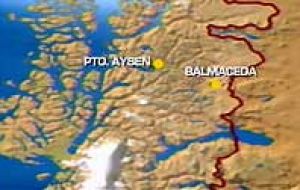MercoPress. South Atlantic News Agency
Deadly quake and “mini tsunami” strike south Chile
 The quake registered 6.2 on the Richter scale at Pto. Aysen
The quake registered 6.2 on the Richter scale at Pto. Aysen Search and rescue efforts continued in Region XI Sunday, one day after a substantial earthquake and subsequent “mini tsunami” struck near the towns of Puerto Aysén and Puerto Chacabuco. So far authorities have located the bodies of three people who were swept away Saturday by massive waves in the Aysén Fjord. Seven others are still missing.
The quake, which registered 6.2 on the Richter scale and lasted roughly 30 seconds, struck the region just before 2 p.m. Saturday, causing panic among the area's already jumpy residents and producing major landslides around the Aysén Fjord. The landslides in turn produced a series of huge waves that leapt up along the shoreline of the Fjord, destroying piers and houses, and sweeping 10 people into the water. The mayor of Aysén, Óscar Catalán, was witness to the tragedy. At the time he was traveling by boat toward a spot called Punta Tortuga, where he was planing to deliver communication radios to the area's isolated residents. After the quake struck, Catalán watched horrorstricken as a massive, 20-foot wave pounded the shore and dragged several people into the Fjord. "I'm devastated, wasted. I watched as a giant wave leapt up and consumed six people, and I couldn't do anything about it," the Aysén mayor told reporters. The victims were identified as Ricardo Figueroa and his daughter Melissa; and Evaristo Contreras, swept away together with his wife, granddaughter and daughter-in-law. Four other people, identified only as salmon farm workers, also went missing Saturday. President Michelle Bachelet was informed of the tragedy immediately and, on Sunday, arrived in Region XI to inspect the damage first hand. Accompanying her on her trip south were Interior Minister Andrés Velasco and Carmen Fernández, director of Chile's National Emergency Office (ONEMI). Though by far the most devastating in recent months, Saturday's quake was just the latest in on ongoing wave of seismic activity that has rattled the area since late January. In the last week of January alone an astonishing 1,700 tremors â€" the vast majority of them noticeable only to sensitive scientific equipment â€" shook the area (ST, Feb. 1). For startled residents in Puerto Aysén and Puerto Chacabuco there's been little relief since. On Feb. 23 a quake registering 5.2 on the Richter Scale struck the area. Five weeks later, on April 1, yet another major tremor, 5.5 on the Richter Scale, hit. Overall, scientists have measured more than 4,000 tremors in just the past three months. When the quakes first began, locals feared a pending volcanic eruption. Nearby Hudson Volcano, located some 85 miles south of Coyhaique, last erupted on August 8, 1991. That eruption, the second largest recorded in Chile, was preceded by a similar cluster of tremors and earthquakes (ST, Jan. 25). Authorities, however, have since come up with another theory to explain the tremors. A team of scientists dispatched to the area in late January concluded that the quakes are likely being caused by an underground magma flow, located below the floor of the nearby Aysén fjord. The magma, which is pressuring a subterranean tectonic plate, could eventually push its way to the surface and form a relatively small volcanic cone on the floor of the fjord, the team surmised (ST, Feb. 14). Residents in central Chile had their own scare early Sunday morning when a noticeable tremor rattled buildings and woke sleeping residents throughout the region. ONEMI identified the epicenter of the quake at approximately 10 miles north of Papudo, Region V. In Santiago, the tremor â€" which took place at 6:35 a.m.â€" registered 4 on the Mercalli scale. A small aftershock hit at 9:55 a.m. The Richter scale measures wavelengths to classify earthquakes based on the amount of energy they produce. The Mercalli scale, in contrast, measures seismic activity using a series of subjective criteria. A trembler noticed by just a few people is considered a 1 on the Mercalli scale, while a quake measuring 5 is felt by almost everyone, awakes sleeping people, and can result in broken dishes, spilled liquids, etc. By Benjamin Witte The Santiago Times - News about Chile




Top Comments
Disclaimer & comment rulesCommenting for this story is now closed.
If you have a Facebook account, become a fan and comment on our Facebook Page!